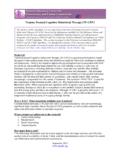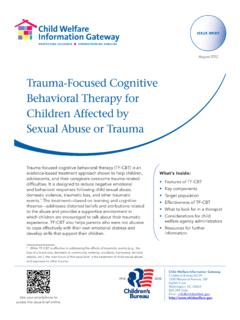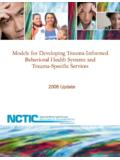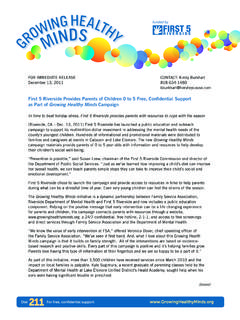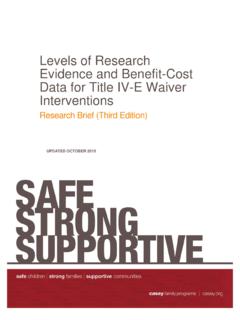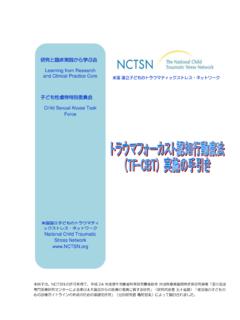Transcription of Preparing and Supporting Foster Parents Who Adopt
1 Child Welfare Information GatewayChildren s Bureau/ACYF1250 Maryland Avenue, SWEighth FloorWashington, DC : FOR PROFESSIONALSJ anuary 2013 Use your smartphone to access this bulletin and Supporting Foster Parents Who AdoptWhat s Inside: Trends in Foster parent adoption Benefits of Foster parent adoption Costs of Foster parent adoption Practice implications with children and Parents Pre- and postadoption services Questions for further researchChild welfare practitioners are increasingly aware of the importance of Foster Parents as permanency resources for children and youth in Foster care. Many children in Foster care who become available for adoption are adopted by their Foster Parents .
2 In order to facilitate these types of adoption, professionals should be knowledgeable about the benefits, costs, and practice and Supporting Foster Parents Who denSainuao atd Suad FdsWhA Wan2 WaWepgdeohg W3a4s5 6 d7a5r 2aWse28aps7aFS np aAd Wega9reSWa1 Stnd a02tsdinges2a ng 5nu3a 6neSnoS as2Se2 angarggFp 5553 AreSW5 Stnd 38s6 Fhop t tspFds Trends in Foster Parent AdoptionFoster Parents are the most important source of adoptive families for children in the child welfare system. According to the Adoption and Foster Care Analysis and Reporting System (AFCARS), in fiscal year 2011, 54 percent of children adopted from Foster care were adopted by their Foster Parents ( Department of Health and Human Services, 2012).
3 Data from the 2007 National Survey of Adoptive Parents (NSAP) and the 2007 National Survey of Children s Health (NSCH) show that among children adopted from Foster care by nonrelatives, 8 out of 10 (80 percent) were adopted by their Foster Parents (Office of the Assistant Secretary of Planning and Evaluation, 2011). Foster Parents were not always preferred candidates for adoptive parenthood. Earlier in child welfare practice, distinctions were made between Foster Parents , who were seen as temporary caregivers, and adoptive Parents , who were specially matched with a particular child for permanent placement. Additionally, if Parents decided to discontinue Foster parenting after they adopted, or if the number of children in the home after a child s adoption exceeded the number allowed by State policy, then the agency lost a Foster home.
4 The practice of discouraging adoption by Foster Parents continued through the mid-1970s, when two in three States either prohibited or warned against the practice (Festinger, 1974). By the early 1980s the tide had turned, influenced by a combination of Foster parent activism and permanency planning projects that demonstrated the benefits of Foster parent adoption. The result was the passage of the Federal Adoption Assistance and Child Welfare Act of 1980 ( 96-272), which supported Foster parent adoption by making subsidies available for children adopted from Foster care (Proch, 1981). It took a great deal of time more than 30 years and the passage of several Federal laws to shift practice toward acknowledging the important role Foster Parents play in achieving permanence for children and youth.
5 Now, Foster Parents are recognized as valuable resources for waiting children. While 26 States give priority to a child s relatives when he or she enters out-of-home care, 28 States provide procedures for Foster Parents to Adopt when their child becomes legally free for adoption. More information on these State procedures and requirements is available in Information Gateway s Home Study Requirements for Prospective Foster Parents : #Page=7&view=Fit). Foster parent adoption is also the basis for two well-recognized practices in adoption, legal risk placements and concurrent planning. In legal risk placements, children whose situations indicate that parental rights will likely be terminated legally freeing children and youth for adoption are placed with Foster Parents who are willing to Adopt .
6 In concurrent planning, a practice supported by the Adoption and Safe Families Act (ASFA) of 1997, the permanency goal of reunification is supplemented by an alternative goal (often, adoption) to ensure that if reunification is not possible, the child has a clearly identified permanency option that can quickly be put in place. Children and youth are often placed with Foster families who would Preparing and Supporting Foster Parents Who denSainuao atd Suad FdsWhA Wan2 WaWepgdeohg W3a4s5 6 d7a5r 2aWse28aps7aFS np aAd Wega9reSWa1 Stnd a02tsdinges2a ng 5nu3a 6neSnoS as2Se2 angarggFp 5553 AreSW5 Stnd 38s6 Fhop t tspFdsconsider adoption should reunification with birth Parents or other relatives become impossible, thus minimizing the number of placements children experience.
7 For this model to work, these Foster Parents must be able to support both the reunification plan, as well as the plan for adoption. After the passage of ASFA, adoption from Foster care increased 65 percent between 1997 and 2000. Additionally, Foster parent adoption increased after ASFA s passage 28 percent between 1998 and 1999 alone (DeVooght et al., 2011). More information on concurrent planning is available in Information Gateway s Concurrent Planning: What the Evidence Shows: The Fostering Connections to Success and Increasing Adoptions Act of 2008 also promotes Foster parent adoption. This law included provisions aimed at increasing adoption from Foster care.
8 Among these were the requirements that States inform prospective adoptive Parents , including Foster Parents , about the Federal adoption tax credit available to those who Adopt a child with special needs (DeVooght et al., 2011). Other provisions included funds for Kinship Navigator programs, through new Family Connection grants, to help children in Foster care locate relatives. The National Resource Center for Permanency and Family Connections (NRCPFC) published an information packet titled Kinship Care and the Fostering Connections to Success and Increasing Adoptions Act of 2008 that provides facts and statistics on kinship care and the kinship care policies and provisions in the Fostering Connections Act: information on Fostering Connections, ASFA, and other important child welfare legislation is available through Child Welfare Information Gateway s publication Major Federal Legislation Concerned With Child Protection, Child Welfare, and Adoption.
9 Benefits of Foster Parent AdoptionUnlike most other types of adoption, children, youth, and Foster Parents involved in Foster parent adoption have already spent time living as a family before the adoption is initiated and have had the opportunity to make some initial adjustments. In addition, research indicates that children waiting for adoption by their Foster Parents are less likely to experience disruption than children in nonrelative, non- Foster -parent adoption (Berry & Barth, 1990; McRoy, 1999; Smith & Howard, 1991). For children and youth, some of the other benefits include: A continuing and legally secure relationship with Foster Parents they know and trust An end to the uncertainty of Foster care and, for many children, a positive psychological shift in their sense of identity, connection, and belonging (Triseliotis, 2003) The chance to remain in a familiar community, school, and neighborhood Tendency for shorter time to permanency than in other types of adoption (Howard & Smith, 2003)
10 Preparing and Supporting Foster Parents Who denSainuao atd Suad FdsWhA Wan2 WaWepgdeohg W3a4s5 6 d7a5r 2aWse28aps7aFS np aAd Wega9reSWa1 Stnd a02tsdinges2a ng 5nu3a 6neSnoS as2Se2 angarggFp 5553 AreSW5 Stnd 38s6 Fhop t tspFds Greater likelihood of maintaining an ongoing connection with the birth family than in families formed through matching (Howard & Smith, 2003) Experienced Parents to manage their needs (often including emotional and behavioral challenges due to trauma and complicated life histories) An established legal permanency for children and youth who would otherwise be wards of the court For the adopting family, the advantages of adopting a child in their care include.











